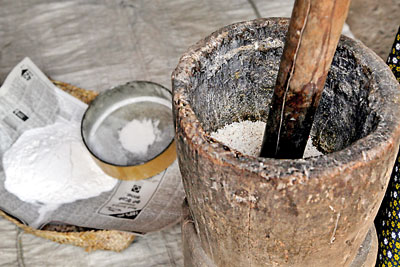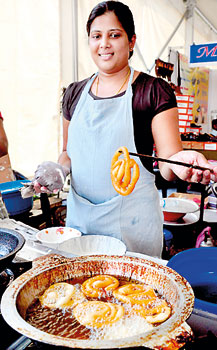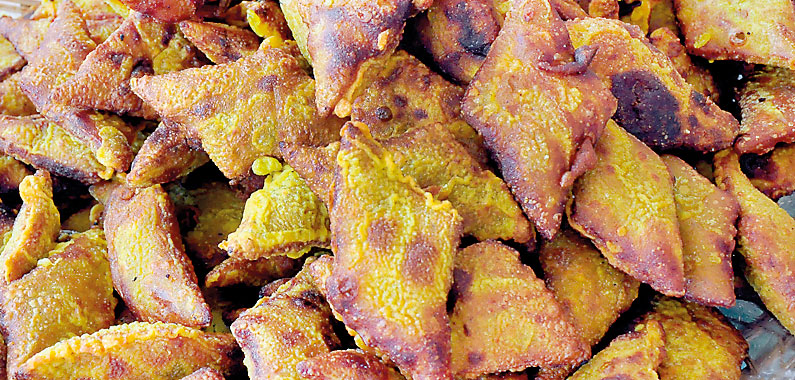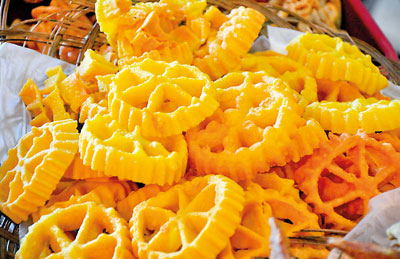Sweet labour
View(s):By Rajitha Weerakoon
Women, clad in colourful “cheeththa redde” rhythmically pounding rice in the “vangediya,” to be used as the base for avurudu delicacies is a sight often encountered on TV.
Although technology has taken over the tasks of traditional implements such as the mortar and the pestle, such scenes take us back thousands of years when much care and hard labour went into the making of mouthwatering sweetmeats such as konda kavun, mung kavun, athiraha, aggala etc., the popularity of which have stood the test of time to be identified today as our traditional avurudu sweetmeats.

Being an agrarian society, the movement of the Sun played a dominant role in the agricultural calendar throughout history. It was a happy coincidence for our farming forefathers that the completion of the twelve-month journey of the Sun, coincided with the harvesting season when the new rice was brought home and the “atuwa” overflowed.
This was also spring time in Sri Lanka when nature yielded its bounties. And being free of work on the field, it was a holiday spirit that pervaded in the month of “Bak” – Bak meaning good fortune when people had the time to let themselves go while tucking into their favourite sweetmeats.
The solar movement from Pisces to Aries therefore, was an event of much significance in the lives of these farming people and the time of the Sun’s transition as worked out by the astrologers – which was the dawn of the Aluth Avurudda was observed to precision with a burst of joyous raban-playing. Fire crackers have taken over the heralding today.
With the boiling of the milk on the hearth at the auspicious hour – an act which symbolised prosperity, people commenced the daily tasks in the New Year. The milk was allowed to overflow to ensure that the household would be in luck’s way throughout the year. All rituals in fact, were traditions associated with common but vital household chores that affect the wellbeing of the family – from the kindling of the kitchen hearth, the consumption of the first meal, the commencement of work, the anointing of oil to the first money transaction.

Preparing the Avurudu rasa kevili. Pix by Mangala Weerasekera
Ground was prepared however for the Avurudu festivities well ahead as “it was the greatest feast of the Sinhalese” as Robert Knox stated in his “An Historical Relation of the Island Ceylon.” Men who had been toiling in the fields had brought the paddy home from the Maha cultivation. It was thereafter, the turn of the womenfolk to pound the paddy, winnow and have the rice ready for the array of preparations to be made from kiribath, the festive meal to the making of numerous “avurudu kevili”.
The custom of helping each other among the community, particularly in the laborious chores, was in evidence in the rural areas. Sweetmeats for instance were not made just for the family as the custom was to share. Carrying trays of sweetmeats accompanied with bananas to neighbouring houses is a familiar sight even today.
For almost all avurudu sweetmeats, the base essentially was flour pounded from the “aluthsahal”. To make “athiraha”- a small flat round kavun, the name of which means “exceedingly delicious”, the roasted rice powder was mixed with indigenous coconut or kitul treacle and rough rice powder (kappi). The kavun or the oil cakes were fried in the special “thel or kavun thachchiya” set apart for the purpose. When a cupful of mixture made with roasted rice flour and treacle was immersed in the boiling oil and fried bringing out the “konde” (the coiffeur) with the skilled maneuvering of an ekel, it carried appropriately the name “konda kavun.”
These, as well as mung kavun – the rice mixture mixed with green gram powder and fried dipped in batter, “aggala,” “aasmi” or “aluva,” ingredients for which came directly from our rice and chena fields, have today evolved as traditional Lankan rasa kevili unique to Sri Lanka. The cultural dimension these have given to the Aluth Avurudda is unparalleled.
Ancient literature recognised “sivusetakala” or 64 cooking methods as having existed in Sri Lanka of which many surely may have been the art of making sweetmeats. We also have relics left behind by the colonialists in the fifteenth and the sixteenth centuries which have further flavoured Lankan cuisine.
The famed Dutch “kokis” derived from the Dutch cookies, has not only remained a crisp favourite amongst us but has even crept into the Lankan traditional kevili list. However, these have happily blended with those which have lasted for thousands of years widening our tastes and delightfully diversifying our array hopelessly spoiling those with a sweet tooth.


Follow @timesonlinelk
comments powered by Disqus















